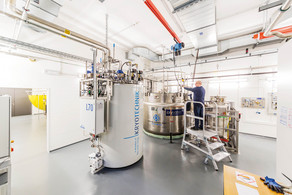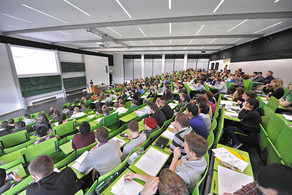Innovative Time Measurement for Ultrafast Electron Processes
- Research

For a decade now, X-ray free-electron lasers (XFELs), such as the Linac Coherent Light Source in Stanford, California, USA, have been capable of producing intense and very short X-ray pulses. With the help of this technology, it is possible to take pictures of materials at atomic level before radiation damage destroys the sample. In addition, it is possible to observe very fast processes on the time scale of electron motion. A 40-strong international research team has now shown that this is even possible in the range of attoseconds (1 as = 10⁻¹⁸ s).
The team studied a fundamental process by which an atomic system releases energy after being bombarded with an X-ray pulse and releases electrons in the process. This is known as the Auger process. “The X-ray pulse excites the atom,” explains Helml. “We then observed how it de-excites and relaxes, as it were.”
Through the radiation, the atom is first of all ionized by the release of an electron known as a photoelectron. In the Auger process, another electron first fills the hole left behind close to the nucleus and in turn gives off part of its energy to a third, weaker bound electron. As a result, this Auger electron can also leave the atom. The research team wanted to explore the question: At which time interval does the Auger electron follow the photoelectron in the case of the noble gas neon? The problem: Conventional measuring techniques are not precise enough to observe such fast processes on the scale of just a few femtoseconds (a millionth of a billionth second). Any flickering when the neon atoms are excited by the X-ray laser, known in technical jargon as a jitter, disrupts the measuring process. It takes ingenuity to obtain a precise result from ten thousand blurred images.
New method: Self-referencing streaking
The key to more a precise observation is an innovative way for modulating the energy distribution of the Auger electrons and the photoelectrons, which subjects them to a common temporal order that can be measured. The first author of the study, Dan Haynes, doctoral candidate at the Max Planck Institute for the Structure and Dynamics of Matter (MPSD), whose supervisor is study leader Professor Adrian Cavalieri from the Paul Scherrer Institute (PSI), explains the new method: “Self-referencing streaking…” (that is what the method is called) “…allowed us to measure the delay between X-ray ionization and Auger emission in neon gas with sub-femtosecond precision, although the timing jitter during the experiment was in the range of a hundred femtoseconds. This is like trying to photograph the end of a race when the shutter could release at any time in the last ten seconds.”
Junior Professor Wolfram Helml from the Center for Synchrotron Radiation at TU Dortmund University adds: “The temporal measurement of Auger decay in neon corroborates fundamental atomic theories at the frontiers of science and at the same time opens up a broad new field of research with X-ray lasers.” Examples are the structure-specific recording of ultrafast electronic processes with significant consequences for the behavior of complex organic molecules and for the development of functional materials, but also imaging methods that make it possible to “photograph” individual molecules with the X-ray laser in the first place.
Researchers from the Max Planck Institute for the Structure and Dynamics of Matter (MPSD), the German Electron Synchrotron (better known as DESY) and the European XFEL in Hamburg, the Paul Scherrer Institute (PSI) in Switzerland, TU Dortmund University, and from many other institutions in seven countries are working together in the international research team.
Original Publication: Haynes, D.C., Wurzer, M., Schletter, A. et al. Clocking Auger electrons. Nat. Phys. (2021). DOI: 10.1038/s41567-020-01111-0








